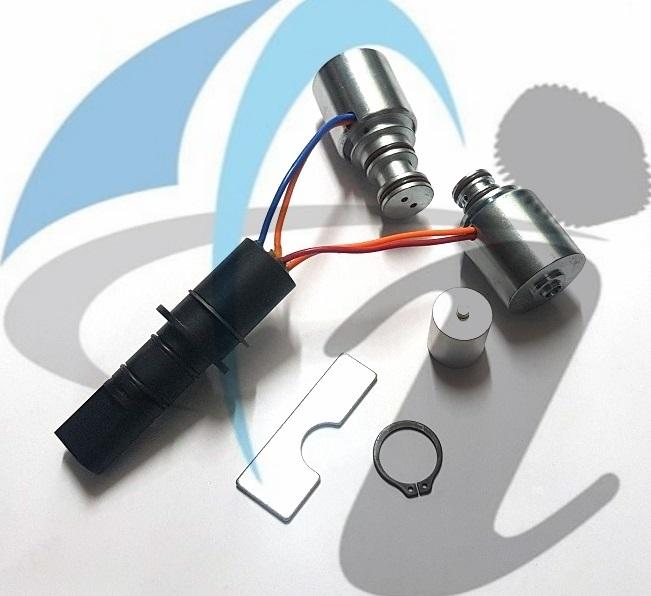
So you should see system voltage on pin 47 of the C2 connector. Current travels from the ignition switch, through each solenoid, and to the computer, seeking ground. One way to diagnose the ground side is to disconnect the PCM (computer), turn the key on, and check for voltage at pin 47 of the C2 connector. The computer supplies ground to the 2-3 solenoid through pin B in the case connector (figure 1). You won’t be able to shut the engine off until you disconnect the jumper wire. IMPORTANT: When you tap into pin E with a jumper wire, you’re basically hot-wiring the vehicle. If the problem is still there, remove the bypass and check the ground side of the circuit. If the problem goes away, you’ll need to test the power circuit for loose connections, breaks in the wire, or additional resistance.
Shift solenoid code#
Monitor voltage at pin E while the code sets. Inspect the connector for corrosion, loose pins, and oil intrusion. Pin E receives voltage from the ING 0 fuse and should have system voltage with the key on. Let’s move on to the transmission connector (figure 2). If there’s no voltage on either side of the fuse, look for a bad ignition switch or a problem in the wiring between the ignition switch and the fuse.īecause an ignition switch can cause intermittent problems, it’s a good idea to wiggle the key around while you’re checking for voltage. With the key on, check for system voltage on both sides of ING 0 fuse. Those of you who’ve been doing this for some time know that bad contacts in the ignition switch can cause an intermittent power problem. One thing to keep in mind is that the power at the ING fuse comes from the ignition switch. So never assume that the power circuit is okay just because there’s only one DTC in memory. But in many computers, as soon as one solenoid code sets, the computer stops checking for other circuit problems. Since the power circuit feeds five solenoids, you’d think a power feed problem should set DTCs for all of them. From there it feeds the TCC, TCC PWM, 1-2, 2-3, and 3-2 shift solenoids. This is a 10-amp fuse in the I/P fuse block, and it provides GEARS December 2016 15 voltage to the case connector at the transmission. Power for this circuit comes from the ignition switch through the ING 0 fuse. That’s well below the voltage needed for a shift solenoid to function properly. Testlights will light up with as little as eight volts some even less. IMPORTANT: Never use a testlight to diagnose electrical problems on computer circuits. So, let’s break down each part of the circuit. Remember, it’s always easier to diagnose one thing at a time. With all these possible problems, the question of where to start comes up.

This includes power, ground, wiring, connections… and even the computer. Keep in mind that, with most solenoid electrical codes, any problems in the circuit can cause the code. Let’s look at the 2-3 shift solenoid circuit (figure 1). That brings a whole new picture into play or should I say circuit?

Ah ha! Almost the same, except for one small word: circuit.

In the factory manual, DTC P0758 reads 2-3 shift solenoid circuit electrical. One of the features of the ATRA HotLine is that we have a wide selection of factory manuals.

Let’s look at that code definition again: 2-3 shift solenoid B electrical problem. You reconnect your scan tool only to discover the same 2-3 solenoid trouble code. But before you can back out of the shop, the MIL is flashing again.
Shift solenoid install#
The DTC says that shift solenoid B has an electrical problem, so you install a new shift solenoid B, a new filter, and bolt the pan back up.Īfter you fill the transmission, you’re ready for the road test. So you put the Hummer on the lift and drop the pan. You check for codes using a scan tool and find DTC P0758: 2-3 shift solenoid B electrical problem. But if you’re a technician who appreciates a new look at a common problem, never dealt with solenoid codes, or are new to the industry, keep reading.įor this scenario, we’re going to use a 2003 Hummer H2 6.0 engine with a 4L60-E the MIL is flashing and the transmission is in failsafe. If you’re one of those technicians, this article may not be for you. Many of you have the answers seconds after you check for codes. Most of you have been dealing with these types of problem for years. A common call to the ATRA HotLine has to do with solenoid circuit problems.


 0 kommentar(er)
0 kommentar(er)
